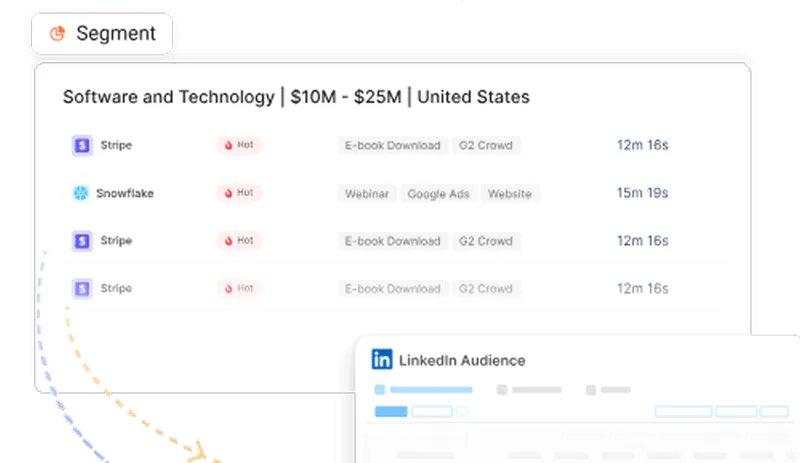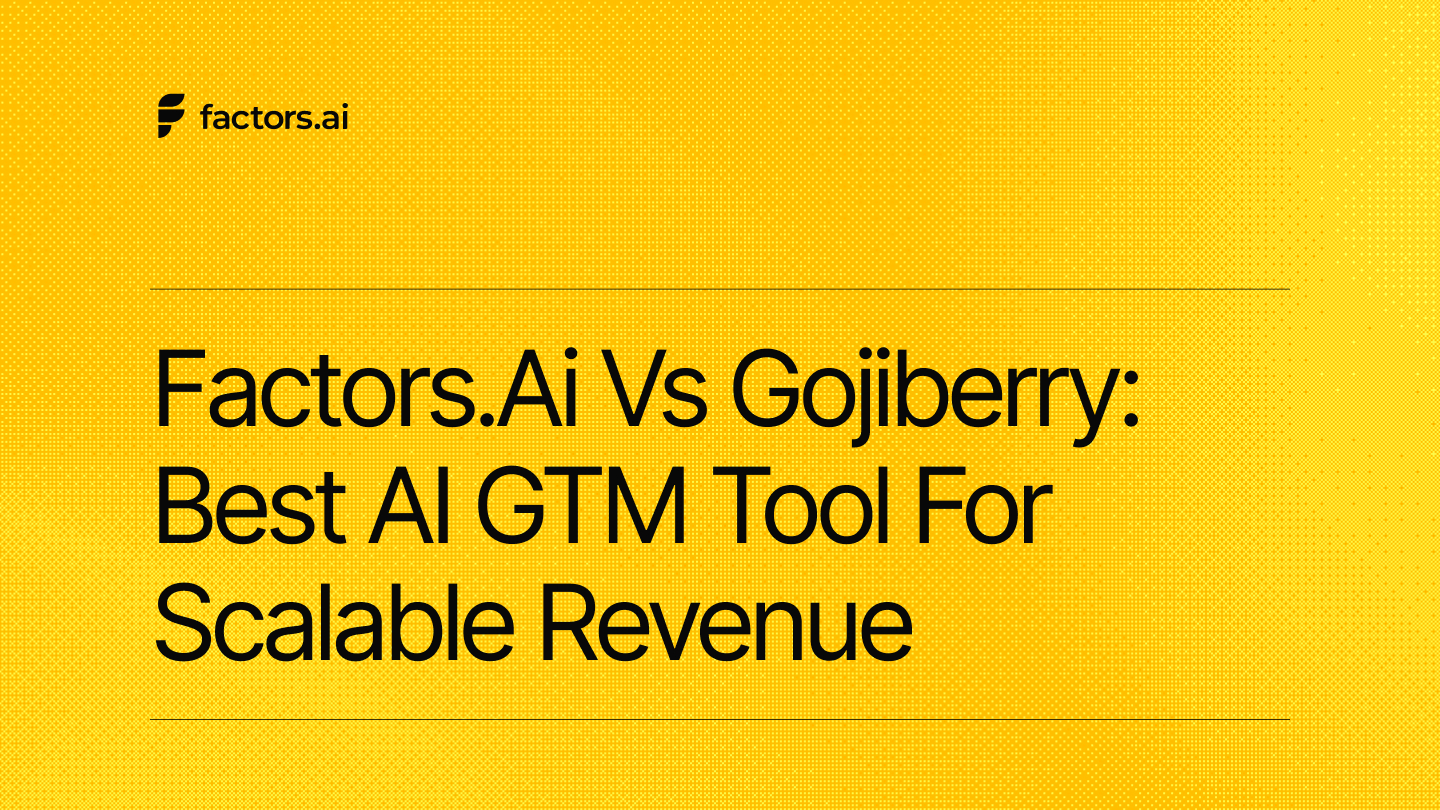9 Best Heap Alternatives: Key Features, Pricing, and More
Discover the top heap alternatives. We compare each tool’s key features, pricing, and more to find the perfect solution for your data-driven business needs.
Marketing analytics tools have become an integral part of B2B companies. Analytics tools help marketers understand how their target audience interacts with the website, various campaigns, and other touchpoints across the customer journey.
Advanced analytics tools can track and analyze granular metrics such as website engagement and omni-channel conversion. This, in turn, helps teams reduce friction and optimize marketing ROI by scaling campaigns and initiatives that drive results. One such tool is Heap analytics.

Heap is a digital analytics platform that automatically captures and tracks user interactions on a website or app. The tool provides many features, including automatic event tracking, retroactive data capture, and real-time reporting.
But like every other tool, Heap comes with its limitations.
We evaluated the customer reviews and found that poor customer support, insufficient data integrations, and a steep learning curve are some of its most prominent limitations.
This blog will discuss the limitations of Heap and list some comprehensive alternatives for you to choose from. Let us evaluate each alternative, its features, customer reviews, and more in detail below.
Why do users look for a Heap alternative?
To better understand a tool’s pros and cons, customer reviews are the best place to start. We have analyzed review platforms such as G2, Capterra, and Trustradius and found the following about Heap.
1. Poor customer support
Customer support is at the heart of great customer experience. Quick, relevant responses and solutions help users get the most out of the product. Unfortunately, according to reviews, customers find Heap's customer support to be lacking.

{{INLINE_CTA_A}}
2. Manual implementation
There are several cons to manually implementing a marketing analytics tool. Two downsides are a higher risk of errors and increased time consumption.

3. Heap has limited analytics functionality
While Heap is great at what it does, its overall functionality seems to be limited as compared to other alternatives. This results in skewed analysis and misleading insights.


4. Poor data integrations
Limited integration can lead to siloed data and inconsistent reporting across platforms and departments. Heap offers relatively few integrations as compared to other alternatives in the market. This results in the inability to accurately measure and analyze the success of marketing performance.

5. Steep learning curve
The usability of the tool can critically impact the tool’s user adoption and engagement. As you can see from the review given below, the user praises the functionality of the tool but, at the same time, disliked the complexity.


6. Very expensive
Expensive marketing analytics tools put a strain on businesses’ budgets, making it difficult to invest in all necessary tools for them to grow.

The above customer reviews provide an overview of Heap’s limitations. These limitations have led marketers to look for an alternative that best fits their business.
Top 9 Heap alternatives
We have conducted thorough research and compiled a list of analytics tools that best fit as Heap alternatives. Go through each tool to see which is the right choice for you.
1. Factors.ai

Factors.ai is a marketing analytics tool that is purpose-built for B2B companies. Factors helps B2B teams optimize GTM efforts across campaigns, website, and offline events.
It is easy to use and implement and offers no-code integrations with ad platforms, CRMs, MAPs, and CDPs
Its dashboard is intuitive and customizable, helping users to include all crucial customer data in one place. This lets users easily track and analyze all data and generate insights to optimize campaigns.
Factors can help demand generation teams -
- Understand each stage of the customer journey
- Track funnel performance at each stage
- And identify factors that help drive conversion
It can automatically track and analyze content performance and provide insight into what’s working and what’s not.
Key features

1. Event tracking
Factors can automatically track events online and offline. Offline events may include meetings, sales calls, and webinars, which tools like Heap don’t track. Factors also offers retroactive data capturing.
2. User Segmentation
The level of segmentation depends on the customer data available in the tool. With robust integrations with CRM software, Factors can collect more data than other tools and provide efficient user segmentation.
3. User Timeline
The feature helps track and visualize all user interactions and engagements with the website. Factors can track offline touchpoints and incorporate them to provide a detailed timeline on both the user-level and account-level.
4. AI-Powered Insights
The ‘Explain’ feature of Factors uses AI technology to identify the elements that are working in favor of a defined goal and those that aren’t.
5. Multi-Touch Attribution
Factors allows marketers to compare and choose between attribution models that best fit their business. Also, marketers can attribute conversion to the most influential channels by tracking and analyzing all essential touchpoints
6. Account Identification
Factors empowers IP-lookup to identify anonymous companies visiting your website You can get insights into high-intent accounts including where they come from, the industry, and the revenue range, and can use the information to segment qualified traffic from the rest.
7. Path Analysis
Visualize the customer journey at account-level and identify the influential path throughout the journey. With Factors, you can keep track of customers who convert and understand their customer journey in depth.
Integrations
- Hubspot
- Facebook Ads
- LinkedIn Ads
- Google Ads
- Salesforce
- Segment
- Bing Ads
- Rudderstack
- Marketo
- 6Sense
- Clearbit
- Leadsquared
- Drift
- Google Search Console
- Slack
- Google spreadsheet
Customer reviews


Pricing
Factors provides 3 services and the pricing plans are as follows.
Analytics & Attribution
- Starter plan for Early-Stage team – $399 per month.
- Growth plan for High-Growth Marketers – $799 per month.
- Custom and Agency – Contact for a quote.
{{INLINE_CTA_A}}
2. Plausible Analytics

Plausible Analytics is a cookieless, open-source web analytics tool. The tool’s script size is smaller than 1KB, ensuring that website loading time remains the same.
The tool is easy to use and complies with GDPR, CCPA, and PECR privacy laws. It provides a range of features to help facilitate web analytics, which we discuss in the next section.
Key features
1. Traffic Segmentation
The feature enables marketers to segment their visitors with metrics like country, region, city, and entry and exit pages. This allows marketers to understand their visitors and content performance better. Marketers can also create custom events to track and collect the necessary information.
2. Shareable Dashboard
In Plausible Analytics, the dashboard and reports are set to private by default. It also allows users to share the dashboards with the team to facilitate collaboration across departments.
3. Email and Slack Notifications
Get real-time notifications through email and Slack channels about changes in website traffic. Notifications can be set to weekly or monthly and shared with multiple recipients.
Integrations
- Bubble.io
- Carrd
- Hubspot
- Google Data Studio
- Google Search Console
Customer review

Pricing

The tool provides a free trial, and the paid plans start from just $9 per month for 10K visitors. Furthermore, users can get a 2-month free subscription if they bill annually.
3. Matomo (Piwik)

Matomo, formerly Piwik, is third on the list of our Heap alternatives. The tool is one of the leading open-source web analytics platforms available in the market.
The tool focuses on providing pristine customer privacy and complete data ownership. It provides 2 different hosting options, cloud-based and on-premise. While the cloud option makes installation hassle-free, the on-premise option offers more flexibility.
The tool is easy to use and allows users to create custom dashboards, reports, and widgets to suit their needs.
Key features
1. Multi-Touch Attribution
Matomo provides marketing attribution solutions that enable marketers to identify the channels or campaigns that drive more conversions.
2. Event tracking
This feature enables marketers to understand visitor behavior within the website. Marketers can also create custom events to analyze visitor behavior and identify hush-quality leads.
3. Custom Reports
This feature allows marketers to generate reports including all essential metrics they want to track and get valuable insights.
Integrations
- WordPress
- Magento
- MailChimp
- WooCommerce
Customer review

Pricing

The On-Premise hosting is free. Users can download and host it on their servers. A drawback of the on-premise version is that its features are limited, and the users will have to pay additional fees for each feature.
For Cloud, the pricing starts from $23 per month for 50K traffic.
{{INLINE_CTA_A}}
4. Amplitude

Amplitude is a digital analytics platform providing product analytics and web analytics. Though it offers both services, the tool is primarily used for product analytics.
It provides a range of features that help businesses keep track of key metrics like user retention, conversion rates, etc. Amplitude also allows marketers to create cohorts and track performance across different campaigns. Amplitude enables easy setup of funnels and conversion charts.
Key features
1. User Profiling
This feature offers detailed information about individual users, such as behavior, demographic, and more. Marketers can leverage this information to create more personalized campaigns and increase the likelihood of conversions.
2. Website Analytics
With Amplitude, businesses can track all user interactions and understand how they engage with their products. These insights help marketers identify the content and campaigns that resonate with the users and contribute to conversion.
3. User Survey
Amplitude provides a survey option to gather real-time feedback from users. Marketers can use this feedback to optimize their websites and improve customer experience.
Integrations
- Segment
- Slack
- Salesforce
- Optimizely
Customer review

Pricing

Amplitude offers a free Starter plan with limited features. Details about the paid plans Growth and Enterprise are available upon request.
5. Mixpanel

Mixpanel is another analytics tool like Heap and Amplitude. The tool’s primary focus is on product analytics. It can track and analyze customer interactions across different platforms. This helps businesses optimize their products and improve their customer experience.
It offers both coded and codeless implementation depending on the user’s preference. According to their website, it takes a minimum of 30 minutes to implement the tool. Also, you will need the help of some tech experts to implement the coded version.
Key feature
1. Behavioral Analytics
The feature allows user segmentation based on users’ behavior and interactions with the product. The feature further provides data that help marketers personalize their campaigns to drive conversion.
2. Custom Alerts
Get alerts in real-time when defined goals are reached. For example, you can set alerts to get notified whenever a visitor turns into a lead or whenever there is a decrease in traffic. By doing so, marketers can analyze their data and find the factors that are causing these changes.
3. Data Export
Mixpanel allows you to export its data to other tools. Therefore marketers can combine Mixpanel data with other analytics tools' data to get a complete picture of their users’ behavior and preferences.
Integrations
- Google Cloud
- Salesforce
- Zendesk
- Slack
- Hubspot
Customer review

Pricing

The tool offers a free version for 20M events per month. There are two paid plans.
- Growth - starting from $20 up to 300M events per month
- Enterprise - starting from $1667 for 1B + events per month
Contact the Mixpanel team for more details about their plans.
6. Google Analytics

Google Analytics is a website analytics tool that businesses can use to track and analyze their website traffic and user behavior. There is another version specifically for enterprises as well - Google Analytics 360.
Users can add GA's code to their website to get insights into how visitors interact with your website. The key metrics provided by GA include;
- Page views
- Bounce rate
- Session duration
- Conversion rate
With GA, users can learn about visitors' demographics, behavior, and traffic sources. This information can be used to optimize the website and campaigns to improve performance.
Key Note: GA-4, the latest version of Google Analytics, has replaced the previous Universal Analytics.
Key features
1. Real-Time Analytics Data
The tool provides real-time data on website traffic. The data includes but is not limited to, the number of visitors, their location, and the pages they view. Businesses can use this data to better understand the sources that generate high-intent visitors and how they engage.
2. eCommerce Tracking
GA provides features for eCommerce businesses allowing them to keep track of sales and revenue.
3. Custom Reporting
Track the metrics that matter most with custom reports and dashboards. In doing so, marketers can quickly and easily access and analyze the data and make decisions on improving the website and marketing campaigns.
Integrations
- Salesforce
- Zoho
- Hubspot
- Mailchimp
- Campaign Monitor
Customer review

Pricing

Although Google Analytics is free for businesses, Google Analytics 360 is paid and the pricing starts at $150,000 per year.
{{INLINE_CTA_A}}
7. Kissmetrics

Kissmetrics is an analytics tool that helps track and analyze user behavior on websites and mobile apps. The tool provides data into how users interact with their site, which includes;
- Pages users visit
- Sessions per page
- Actions users take
Marketers can use this information to make data-driven decisions on improving user engagement, conversion rates, and overall user experience.
Key features
1. Customer Segmentation
With Kissmetrics, businesses can group users based on shared characteristics. This enables marketers to create targeted campaigns for each segment and improves user engagement.
2. Cohort Analysis
This feature helps track and analyze user behavior by cohorts and identify trends and patterns. For example, it could help businesses determine whether users signed in a particular month will continue to the next month.
3. A/B Testing
Test and compare pages and choose the one that performs better. Therefore the feature helps marketers optimize the user experience and improve conversion rates.
Integrations
- Hubspot
- Magento Go
- Marketo
- Optimizely
- Convert
- Mailchimp
Customer review

Pricing

The pricing plan of Kissmetrics is as follows:
- Silver - $299 per month for 10K visitors
- Gold - $499 per month for 25K visitors
They also offer a custom option. Contact the Kissmetrics team for more information.
8. Contentsquare

Contentsquare is a digital analytics platform that helps businesses understand customer interaction with the website and app. The tool can track and analyze customer behavior and provide information about customer engagement.
By analyzing user behavior and engagement data, the tool helps marketers optimize their websites or apps and improves user experience and drives business growth. In addition, it offers an intuitive user interface and can be used by businesses of all sizes and industries.
Key feature
1. Consumer Behavior
The tool tracks all user interactions and micro-gestures to understand what visitors are doing and why they are doing it. These can help align future marketing efforts with customer needs and goals, improving user experience and conversion rates.
2. Surface Insights
This feature helps pinpoint issues faced by users at any stage of the customer journey. It also helps identify the root problems through session replays and quantify their impact on the brand.
Integrations
- Salesforce
- Google Analytics
- Adobe Analytics
- InMoment
- AWS
Customer review

Pricing

The tool does not provide information about their pricing plans. Contact the Contentsquare team for more details.
{{INLINE_CTA_A}}
9. FullStory

The last in the list of Heap alternatives is FullStory.
FullStory is a digital analytics tool that helps understand user interactions on websites, apps, or digital products.
The tool's conversion report pinpoints user friction and quantifies its impact on KPIs. FullStory also allows a customizable dashboard to visualize all key metrics at a glance.
Key features
1. Funnel Conversions
Automatically tracks all user interactions to see how customers move down the sales funnel. It also helps identify areas of high engagement and areas where users drop off.
2. Website Analytics
Track all key metrics in real-time to understand how your users interact with the website or app. The metrics can include engagement time, clicks, scrolls, and more. It analyzes these metrics and reveals opportunities to improve your efforts.
Integrations
- Salesforce
- Google Analytics
- Optimizely
- Google Optimize
- Olark
Customer review

Pricing

FullStory offers three paid plans
- Enterprise
- Advanced
- Business
The details of the plans are available upon request.
FullStory also provides a 14-day free trial.
Top Product Analytics Tools
Product analytics tools help businesses optimize user experiences and improve product performance by providing in-depth insights into user behavior.
1. Top Platforms: Amplitude, Mixpanel, FullStory, Pendo, and PostHog.
2. Key Features:
- Amplitude: Advanced segmentation, funnel analysis, retention tracking, and powerful data analysis tools.
- Mixpanel: Custom event tracking, detailed funnel analysis, and insights into user engagement across web and mobile platforms.
- FullStory: Session replay, heatmaps, and conversion funnels for understanding user behavior.
- Pendo: Product analytics combined with user feedback and in-app messaging, feature usage tracking, and NPS surveys.
- PostHog: Autocapture, session replay, visual event labeling, feature flags, and surveys with an open-source approach.
3. Strategic Benefits:
- Gain deeper insights into user behavior and product engagement.
- Improve product adoption and customer retention through enhanced data analysis.
- Streamline decision-making with real-time analytics and user feedback integration.
Implementing product analytics tools helps businesses optimize user experiences, refine product strategies, and drive greater product performance.
Takeaway
To conclude, if you are looking for a Heap alternative, there are several options available. The tool you select will depend on your business requirements and goal.
For example, if you are looking to improve your digital product’s performance and user experience, then consider tools like Mixpanel and Amplitude. On the other hand, if you want to improve your marketing efforts, then consider tools like Factors.ai, Google Analytics, and Matomo.
Make use of the free trials offered by each tool to see which is the best fit for your business.
{{INLINE_CTA_A}}
See how Factors can 2x your ROI
Boost your LinkedIn ROI in no time using data-driven insights


See Factors in action.
Schedule a personalized demo or sign up to get started for free
LinkedIn Marketing Partner
GDPR & SOC2 Type II
.svg)









